Brand guides
Authenticating Nike kits
In this guide, we will walk you through the key features that make up a genuine Nike kit, from the fabric quality to the fine details in design. We'll also highlight common signs of counterfeits and provide tips on how to verify authenticity, whether you're shopping online or in-store.
The product code label
The small label located beneath the wash label is one of the most useful first indicators when assessing a kit's authenticity. Despite its size, it can reveal a surprising amount of information.
The product code
Nike product codes are a useful starting point when verifying the authenticity of a football kit. Typically found on a small label beneath the wash label inside the kit, these codes follow a six-digit style number, sometimes followed by a three-digit color code (e.g. 894430-010). The style number identifies the core design or template, while the color code distinguishes the specific variant.
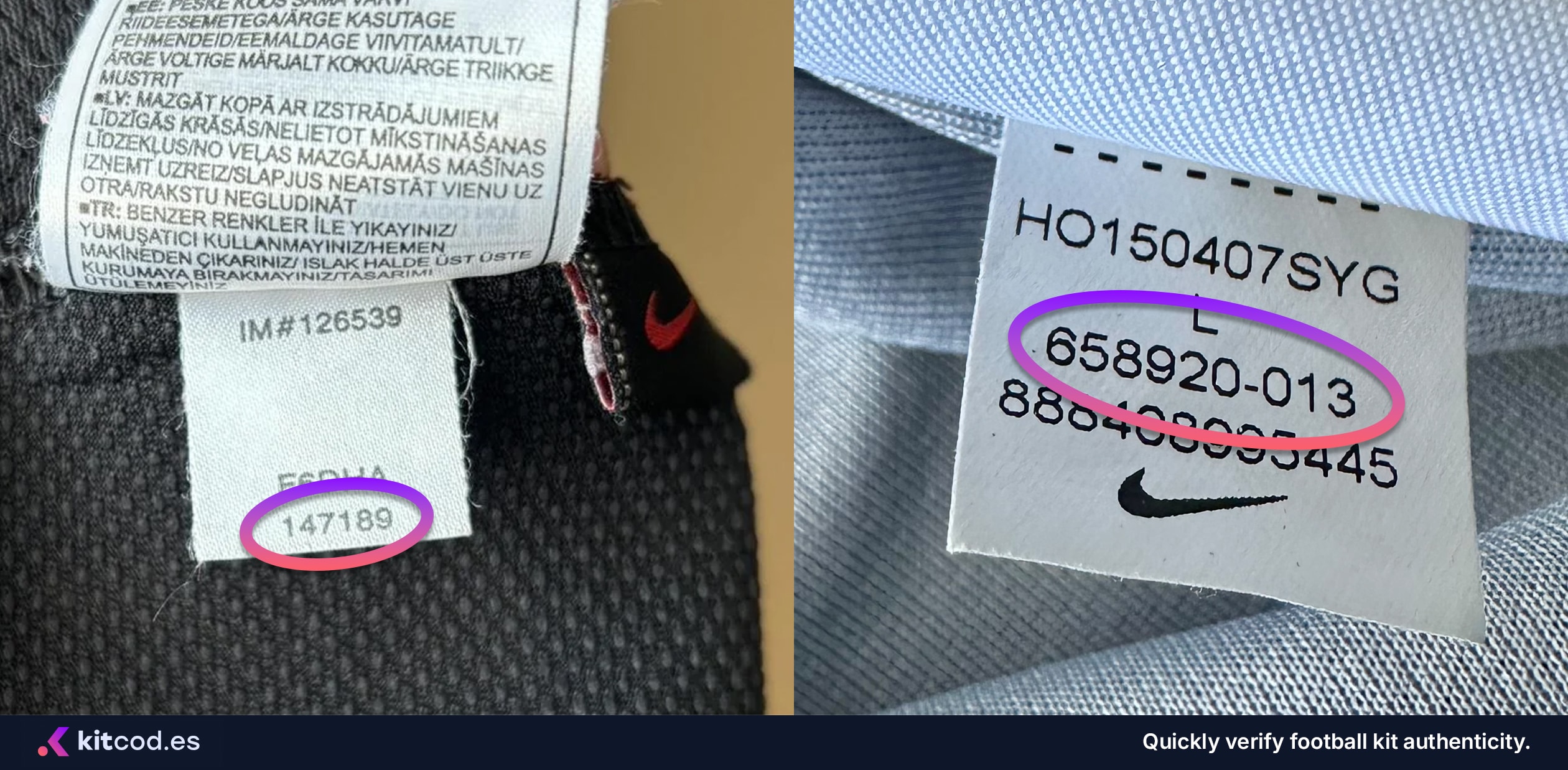
While these codes can help confirm that a kit's design exists and matches what it claims to be, they aren't foolproof. Fake kits often reuse valid codes, and not all genuine kits, especially older models, include the color suffix. For that reason, Nike product codes are best used in combination with other indicators like stitching quality, print accuracy, and label details.
Right code, wrong kit
Counterfeit kits often reuse real product codes to appear more convincing. For example, the France 2020 Away kit uses the code CD0069-100. That code is valid, but only for that specific kit. If you see the same code on a different team's kit, it's almost certainly fake. A matching code doesn't always guarantee authenticity, but a mismatched one is a strong red flag.
The production code
The small label beneath the wash label doesn't just show the product code, it also contains details about when the kit was produced. Nike includes a season code that indicates the production period. Let's use the code in the example below: HO150407SYG.
Nike operates on a four-season cycle, using the following abbreviations:
SP– Spring (January to March) – sometimes shown as just SSU– Summer (April to June) – sometimes shown as just UFA– Fall (July to September) – sometimes shown as just FHO– Holiday (October to December) – sometimes shown as just H
Older kits may display only the season letter followed by a single-digit year (e.g., F6 for Fall 2006). In the late 2000s, Nike transitioned to using two-digit years (e.g., HO15 = Holiday 2015).
The next four digits of this code represent the first and last months of manufacturing. In the example on the right the kit was produced from April (04) to July (07) for a Holiday 2015 release.
This code is especially useful when validating that the kit's production date aligns with its actual season. Counterfeiters often reuse labels across various kits, leading to mismatched or illogical combinations.
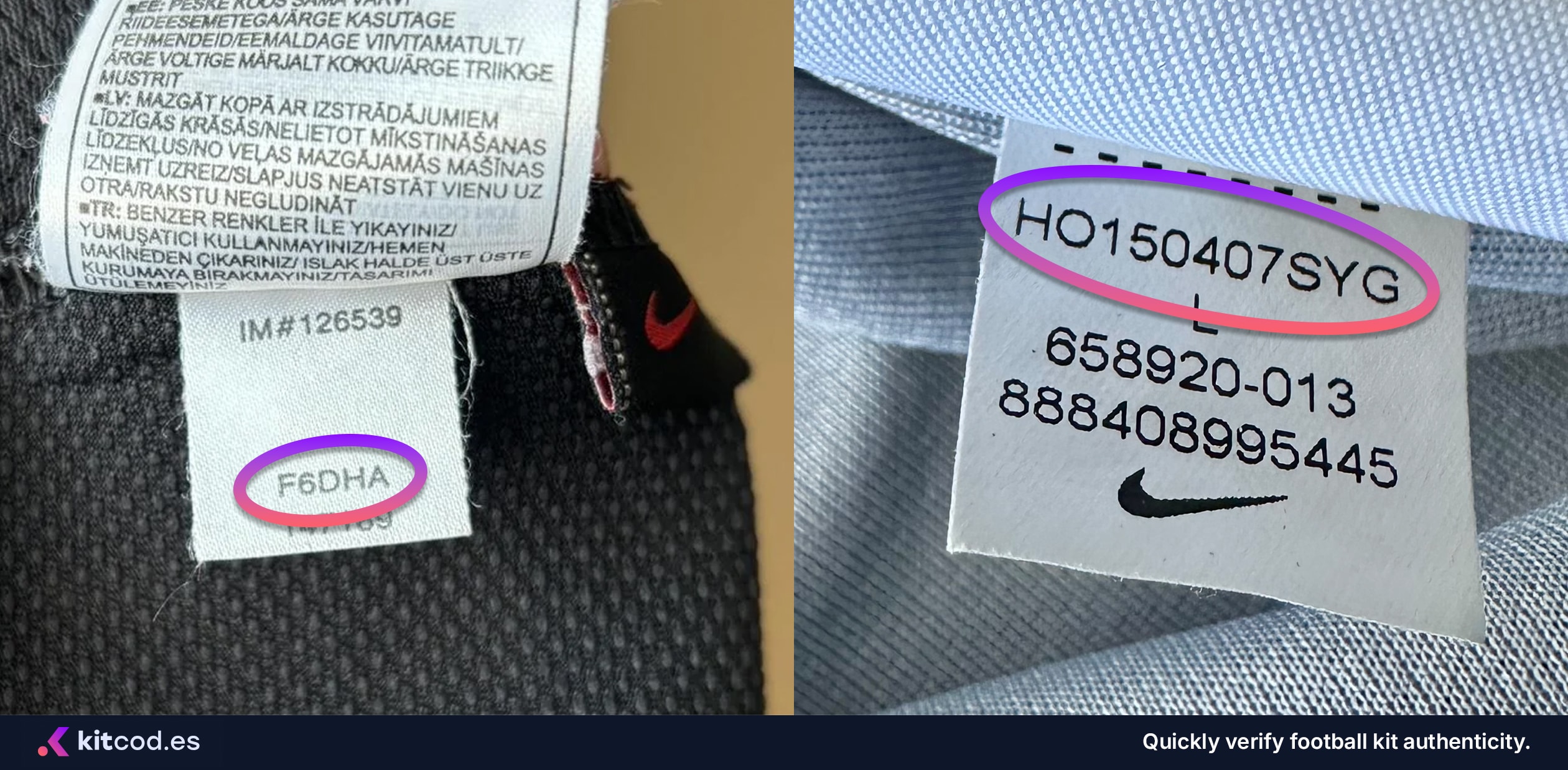
Understanding color codes
As you've learned by now, Nike product codes often follow a [style]-[color] format. This means every product is made up of a base style number followed by a three-digit color code, usually separated by a hyphen. This color code identifies the primary colorway and helps distinguish between design variants.
Kits without color codes
Not all Nike jerseys include a product code with a color suffix. This became more consistent over time, but many earlier kits, particularly from the early 2000s to early 2010s, may include only the base style code. Color codes were introduced gradually during that period.
Let's look at an example:
894430-010– Black version of the design894430-100– White version of the same base design
These codes may apply to different teams, kit types, or even training gear, depending on the color assignment. This becomes especially important when:
- A fake uses the correct style number but assigns the wrong color
- Multiple clubs share the same template but differ in colorway
- You're trying to verify that a tag matches the actual physical kit color
Refer to the chart below for a general idea of how Nike colorways are typically structured. While the exact code may vary slightly by shade, the broader pattern holds, for instance, orange kits won't use codes from the 100s range, which is typically reserved for white-based designs.
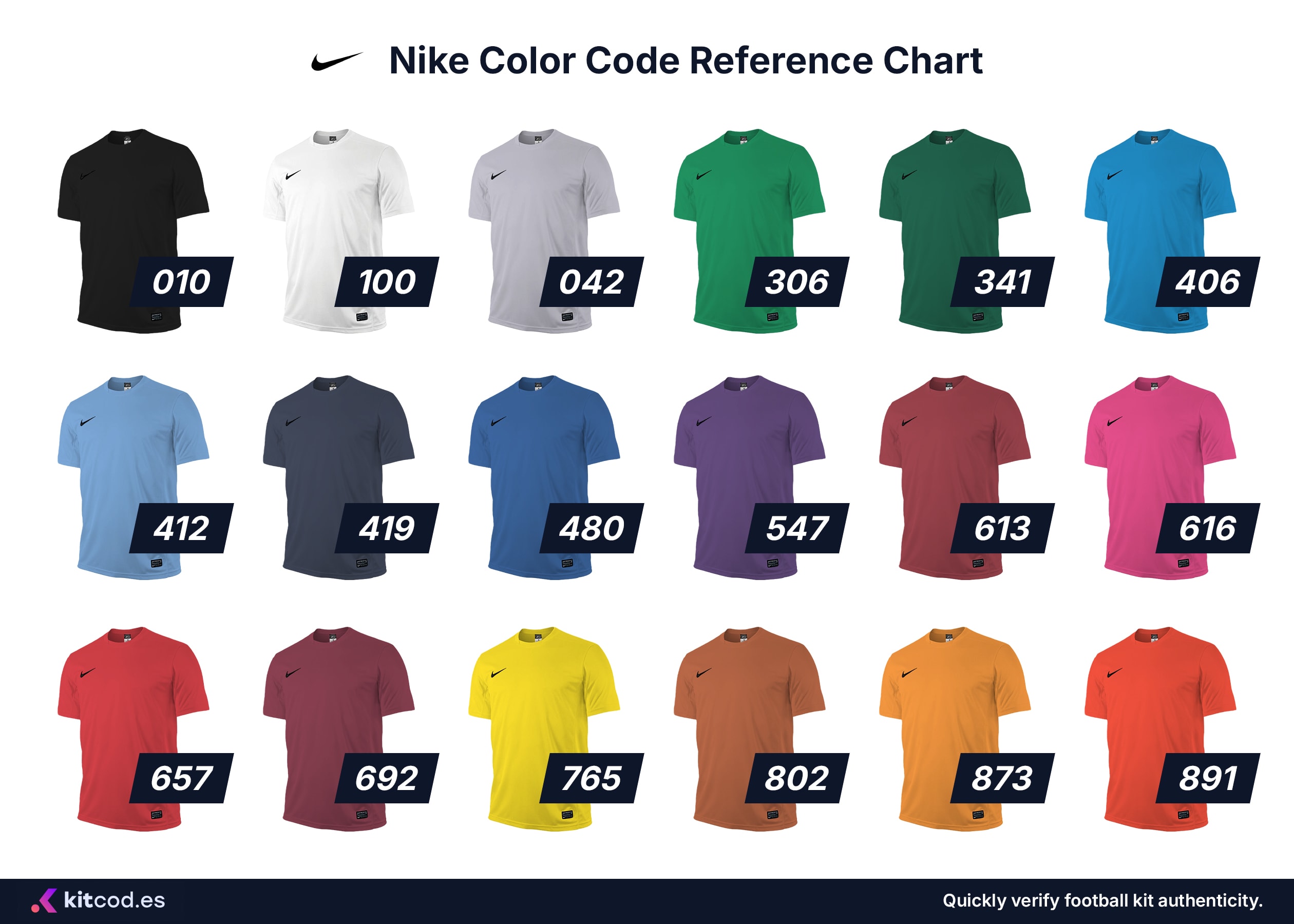
A notable exception to this rule is black and grey, as the distinction between the two can be a bit of a grey area in Nike's color coding 😉 Some grey kits may have color codes beginning with 0 (like black), while others might start with 2 making it less predictable than other color categories.
Sample kits
When authenticating Nike kits through product codes, it's important to understand that sample shirts may not follow the standard format used on retail or player-issued kits. Most Nike product codes typically follow a [style code]-[color code] structure (e.g. 894430-010), but sample kits often include variations, such as:
- Missing or placeholder color codes
- Internal-use style codes not found in retail catalogs
- Extra suffixes like "SS" (short for Sales Sample)
- Different tag formatting or printed-on labels
These deviations don't necessarily indicate a fake, but rather they reflect that the kit was produced outside the normal retail cycle, often for marketing, review, or internal use. However, because of their irregular nature, sample kits should always be examined more closely, with extra attention to stitching, crests, materials, and label quality.
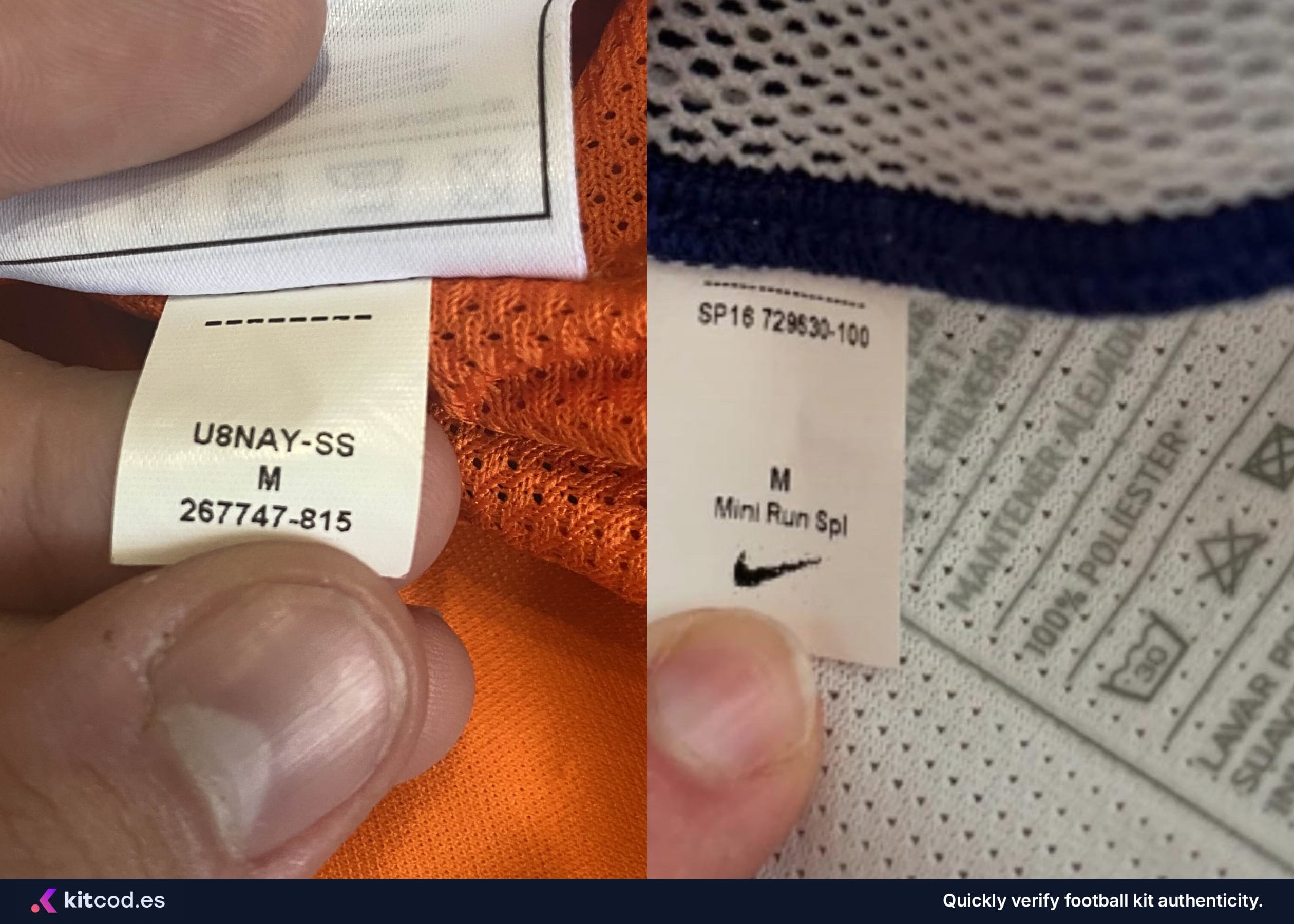
The swing tags
A swing tag is the detachable cardboard tag typically attached to a new kit, usually hanging from the sleeve or neck area by a small plastic barb. It contains key product information like the size, barcode, product code, and pricing. In the world of football kits, swing tags are important for collectors, as they can help verify authenticity and confirm the kit is unworn or in original retail condition.
Placement
The placement of Nike's swing tags has changed over time and can offer useful clues when authenticating a kit.
| Period | Tag location |
|---|---|
| Before 2016/17 | Tags were typically attached at the neck of the kit. |
| 2016/17 to 2020/21 | Tags moved to the armpits, with one tag under each sleeve. |
| 2021/22 onward | Modern kits now feature a single tag, attached to the left sleeve only. |
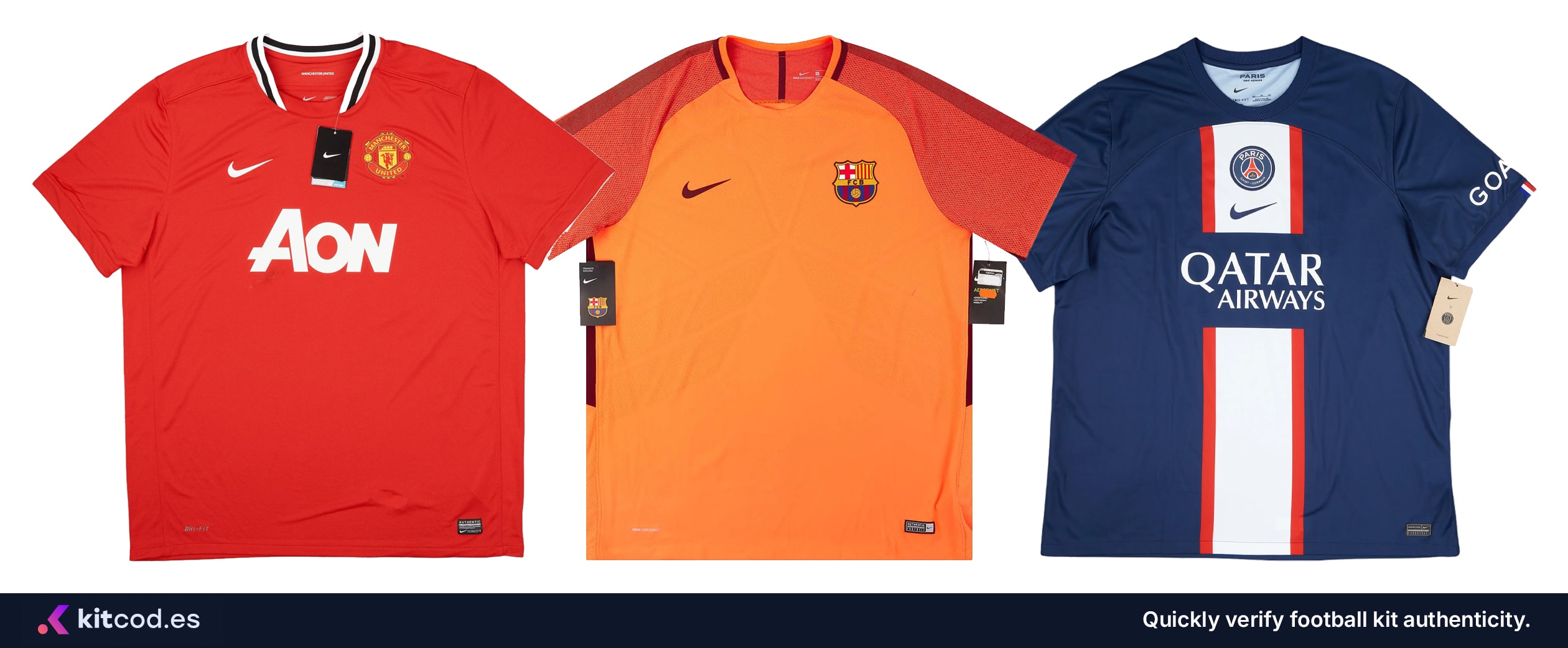
Design
Older Nike swing tags were typically black, while more recent versions have adopted a brown, recycled paper look. These tags include a removable sticker that displays key information such as the product code and sizing. One important detail to watch for is that authentic tags always use a real, physical sticker, never a printed-on label. Additionally, the plastic barb used to attach the tag is consistently black on genuine Nike kits.
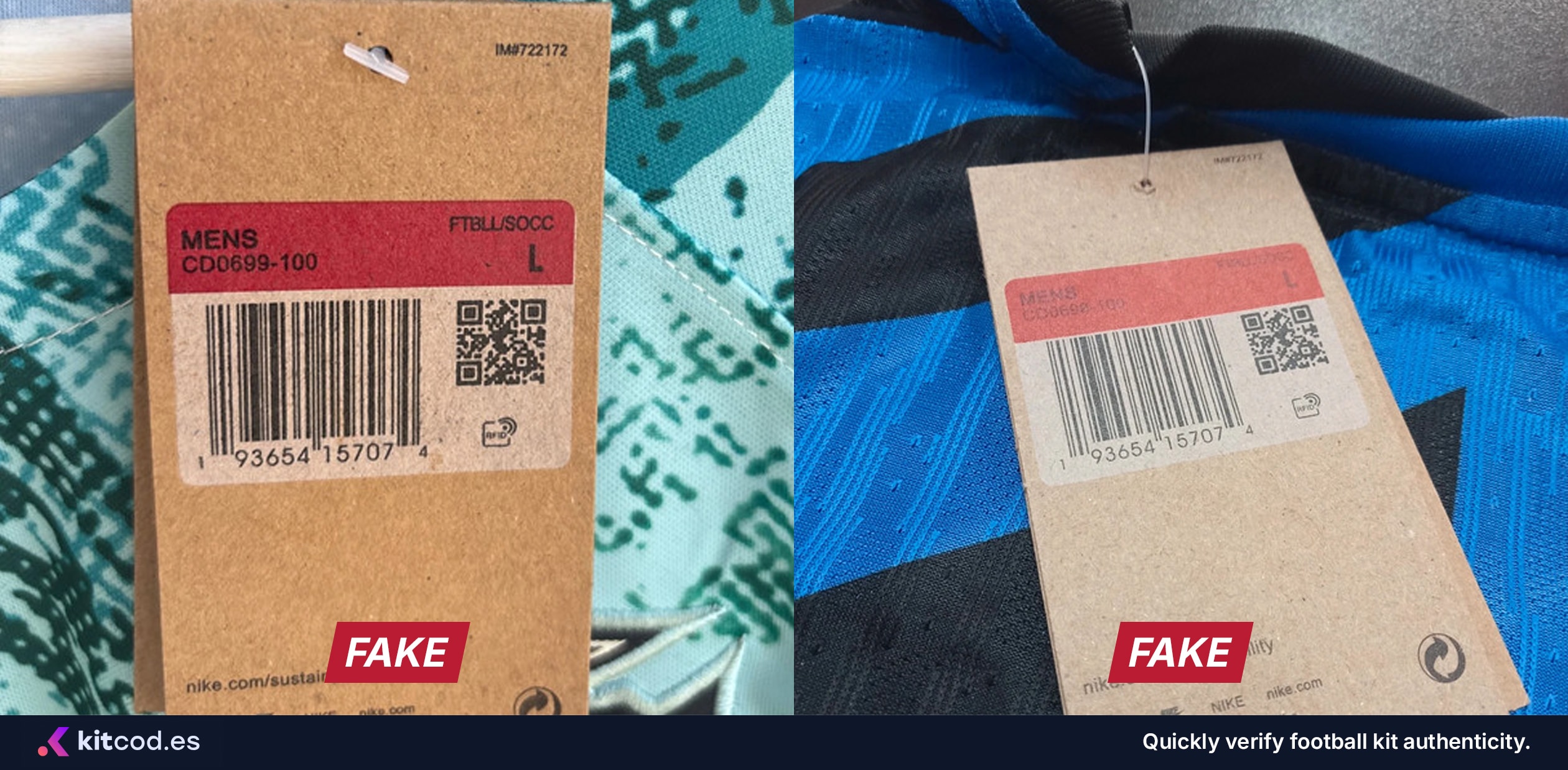
The code on the swing tag should match the one found on the smaller product code label. If the kit includes a color code (e.g., -100 for white), it should also be consistent across both labels. Any mismatch between these codes, or a missing color suffix where one is expected, can be a sign of a fake kit.
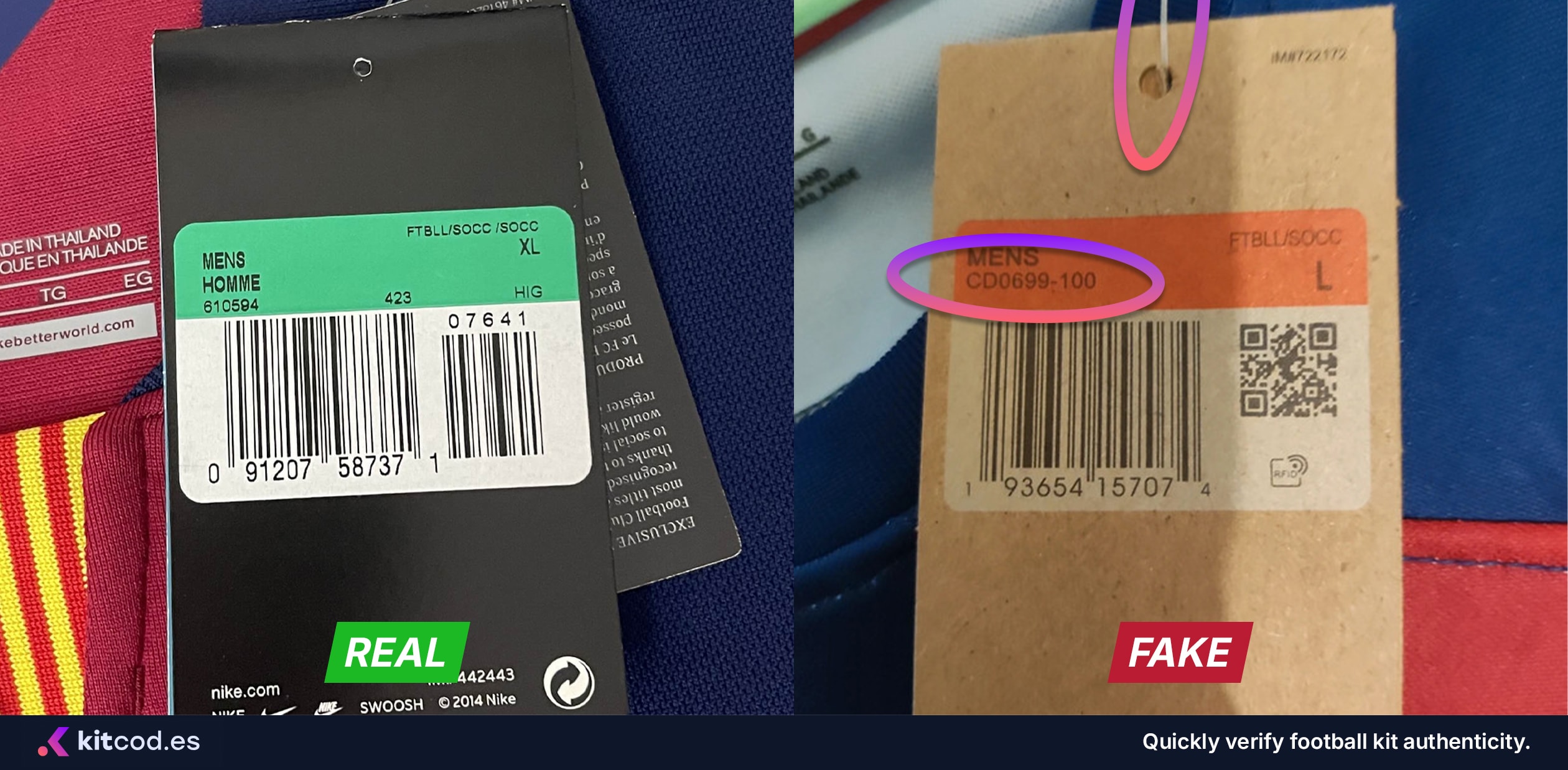
Size color codes
The size sticker features a color-coded bar, which corresponds to the kit's size:
| Color | Size |
|---|---|
| Gray | XS |
| Yellow | Small |
| Blue | Medium |
| Red | Large |
| Green | XL |
| White | XXL and above |
This system has been in place for many years, so if the color on the sizing bar doesn't match the size listed, or if the bar is missing entirely, that could be a sign of a fake.
Player-issue kits
Player-issue kits typically do not include standard Nike swing tags when distributed directly to teams. If they are made available for retail, they may include a store-specific tag, but not the usual Nike swing tag. In the past, some player-issue kits also featured tags attached at the neck, but this practice has been phased out and is no longer seen on modern releases.
The care labels
Nike kits include a care label sewn into the inner side seam. On player-spec kits, this label is often printed directly onto the fabric, rather than sewn in like on fan versions.
Watch out for:
- Typos, text spacing or grammar issues, which are common in counterfeit labels
- Inconsistent manufacturing info, the country listed on the care label should match the one on the neck label
- Pen marks or scribbles, while these can appear on genuine player-spec kits, they may also be signs of secondhand fakes or tampering if found on retail versions
Always compare care label formatting, language, and layout with a known authentic kit from the same season to be sure.

The neck label
The neck label or size print inside the collar is a key detail when verifying the authenticity of a Nike football kit. It typically features details such as the kit size across different regions, the kit technology being used, and a manufacturing country.
Made in ...
The manufacturing country printed on the neck label should always match the one listed on the wash tags inside the jersey. For example, if the neck label says "Made in Indonesia", the inner care/wash tag should say the same. Inconsistencies between these two locations are a common red flag for counterfeit kits. While Nike manufactures kits in several countries (e.g., Thailand, Vietnam, Indonesia, Mexico), the labeling should always be consistent throughout the kit.
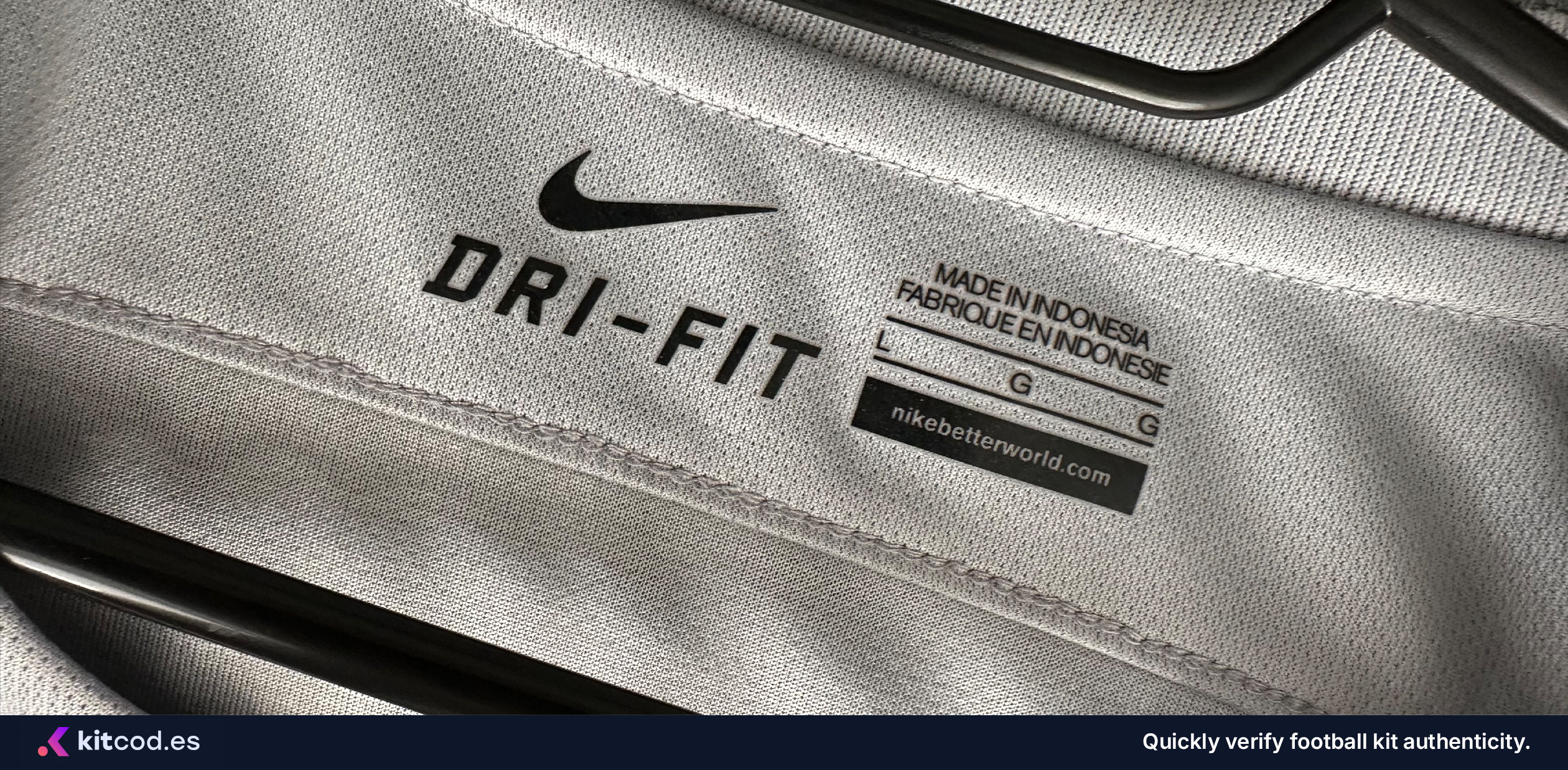
Size information
This size conversion chart shows how kit sizes align across different regions. When verifying a kit's authenticity, the size listed in the neck label should match the corresponding value on the wash tags inside the kit. Pay close attention to the Japanese size (J), counterfeit kits often get this wrong, either by mismatching it with the other sizes or using unrealistic codes (e.g., "J: S" for a US L).
| UK | US | F | D | I | E | CDN | J |
|---|---|---|---|---|---|---|---|
| S | S | S | S | S | S | S/P | M |
| M | M | M | M | M | M | M | L |
| L | L | L | L | L | L | L/G | 2XO |
| XL | XL | XL | XL | XL | XL | XL/TG | 3XO |
| XXL | XXL | XXL | XXL | XXL | XXL | XXL/TTG | 4XO |
The security tag
Most modern Nike kits feature a security tag (also known as an authenticity tag) located at the bottom right of the kit. While the design of this tag has evolved over the years, it typically includes a long alphanumeric code.
Uniqueness
Like the product code, the security tag code can be searched online for reference. However, unlike product codes, which are shared across all copies of a kit, the security tag code is meant to be unique to each kit. If you search it and find multiple listings showing the exact same code, that may be a red flag indicating a fake.
Design details
In more recent Nike kits, the security tag has become more sophisticated. Kits feature a high-quality metallic strip integrated into the tag, often with a subtle holographic effect that shifts under light. Fake kits often skip or poorly imitate this detail, replacing it with a flat printed strip, or even just a piece of stitching. However, certain smaller teams or training kits might not feature a security tag or metallic strip at all.
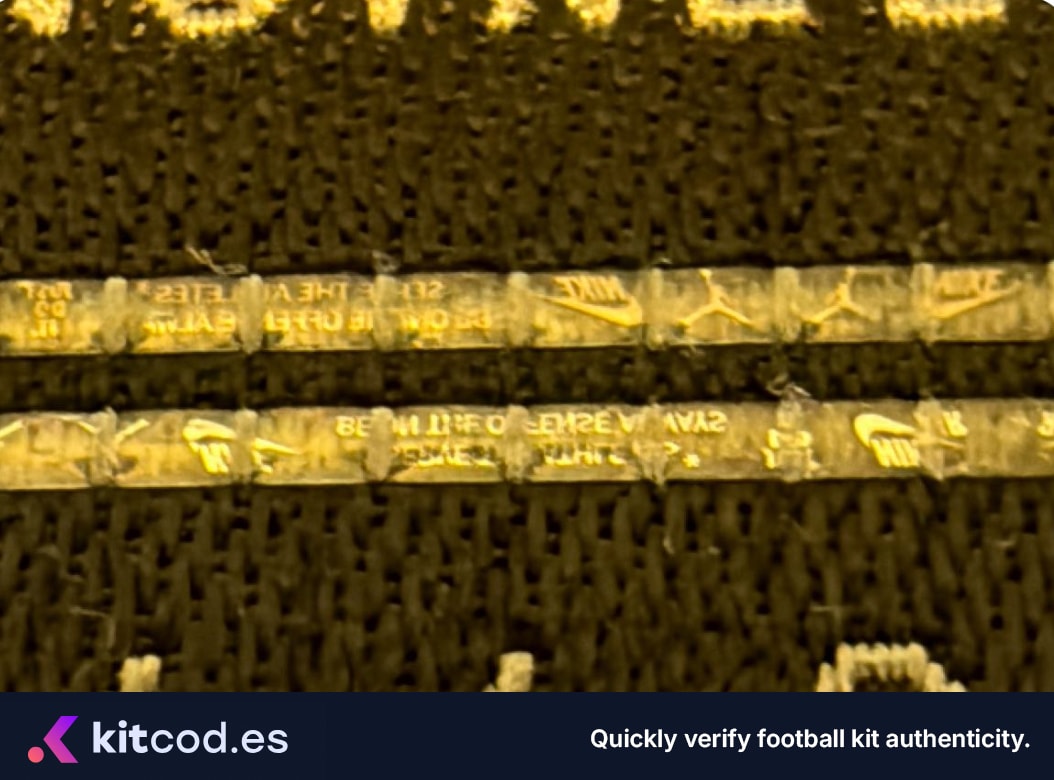
The overall tag design also varies based on the tier of the kit:
- Player-spec kits typically feature gold or metallic accents
- Fan versions tend to use silver or neutral-colored tags
These small design cues can be valuable indicators when trying to confirm a kit's authenticity. Many Nike security tags include subtle built-in security elements to help verify authenticity. For example, the 2005 version often features tiny Nike logos or fragments of the word "SECURITY" embedded within the metallic strip. On the reverse, there's typically a string of numbers, with the first digit appearing more reflective. Counterfeit tags have been known to repeat number sequences like 02301450.
In the 2011 version, certain letters in the word "AUTHENTIC" are stitched in a shinier material than the rest, sometimes it's "HEN", other times it's the two "T"s. These small variations are intentional and serve as low-key authenticity cues.
Timeline
Refer to the overview below for a look at various security tag designs and the years they were first introduced:

Logos, crests, and stitching
The club crest is one of the most noticeable and telling details on a football kit, and a common giveaway on counterfeit Nike kits. While fake kits often get the general shape right, they frequently miss the finer details that set real Nike embroidery or heat-transfers apart.
Embroidered vs. heat-pressed
Nike uses different crest applications depending on the kit type and season:
- Fan versions usually feature embroidered crests. These should be clean, tight, and sit flat on the fabric.
- Player-spec kits often use heat-pressed or silicone-style crests, which are lighter and smoother to reduce weight and irritation.
If the crest is embroidered when it should be heat-pressed, or vice versa, that's a red flag. Authentic Nike crests have crisp, clean edges with no loose threads, fraying, or bubbling. If it's embroidered, it should feel tight and flat. Fakes often feel thicker, stiffer, or roughly stitched.
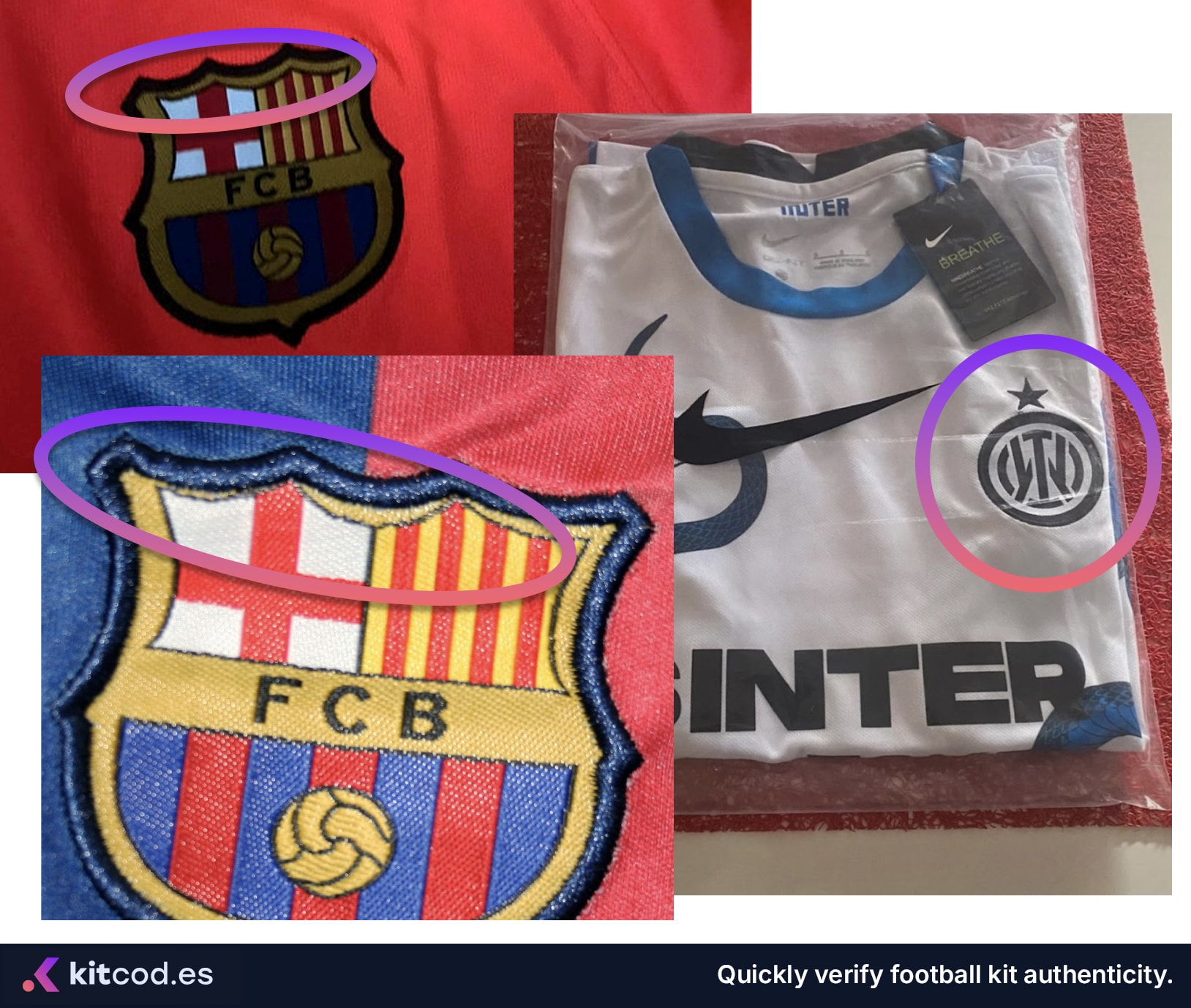
The Nike Swoosh
The Nike Swoosh is one of the most recognisable brand marks in the world, and also one of the easiest ways to spot a fake football kit when something's off. On authentic kits, the Swoosh is applied with precision, whether it's embroidered or heat-pressed. The shape is consistent, the edges are clean, and the overall finish is sharp. Fabric gathering around the swoosh on a brand new kit is also an indicator of a fake. On new kits this should always be flat. It can, however, happen after repeated washing in the case of used kits.
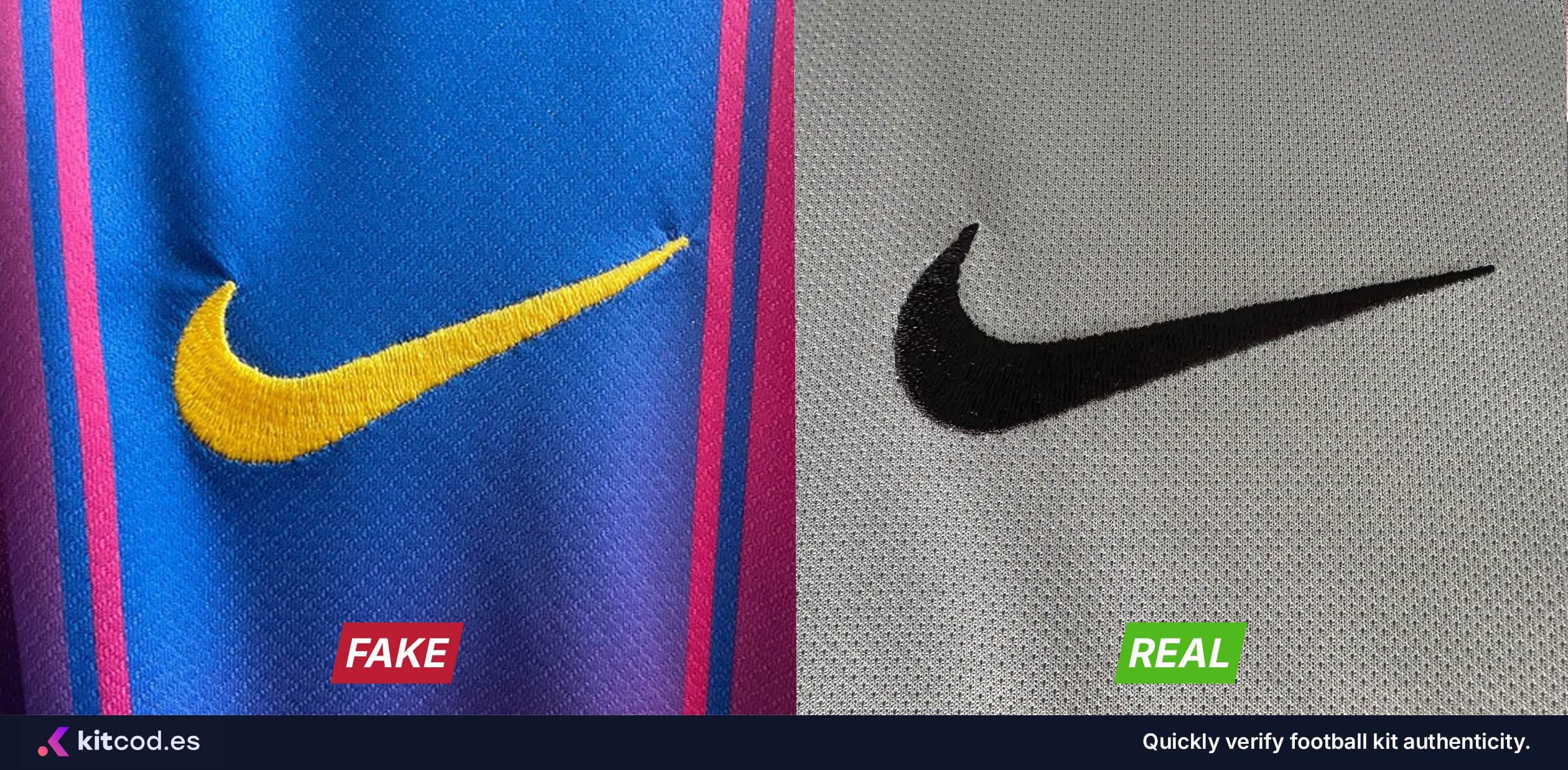
Another giveaway can often be found on the inside of the kit. Flip the kit inside out and check the area behind the swoosh or the crest. If you see excess fabric, loose backing material, or messy stitching, that's a strong red flag, especially on modern Nike kits, where internal finishing is usually very clean.
Common red flags
- Oversized or undersized crests
- Crooked placement or inconsistent spacing
- Rough or overly shiny threadwork
- Crests that peel easily or appear wrinkled (especially on heat-pressed versions)
Pro tip
Compare the listing with official product photos or verified examples from trusted sources. Even minor differences in spacing, stitch density, or the finish of the crest can be enough to spot a fake.
RN56323 and CA05553
The numbers RN56323 and CA05553 are registration numbers that appear on many Nike garments, including football kits. These codes are not unique to individual items or specific products, instead, they are broad identifiers registered with U.S. and Canadian authorities. RN56323 is Nike's U.S. Registered Identification Number (RN), and CA05553 is their Canadian equivalent.
These numbers simply confirm that Nike is the manufacturer, but they are printed on virtually every Nike garment, regardless of style, year, or category. As such, they cannot be used to verify authenticity or date a kit, and they often appear on fake kits as well. While it's good to know what they are, they offer little value when it comes to actual authentication.